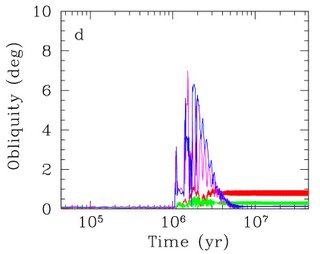Nature 440, 1163–1165 (2006)
When a new, independent code is used for the calculations on which the conclusions of this Letter were based, the results reported for the evolution of obliquity cannot be reproduced. This code was written in the inertial frame and is more reliable than the one used in the Letter. In most runs, the obliquities can change by only a few degrees and attain large values in only a very few cases. In addition, the obliquity variation shown in the Supplementary Information, although correct, originates from changes in the orbital inclination of the planet, and close encounters are not effective in causing large obliquities.
This was a strange episode. I can't recall another case in my field in which a paper in Nature or Science was retracted, not because of malfeasance, but just because the calculations were completely wrong. I feel bad for Brunini.



